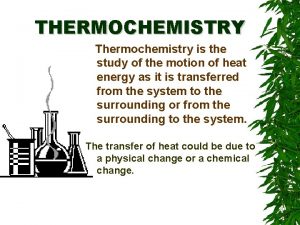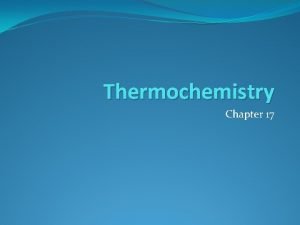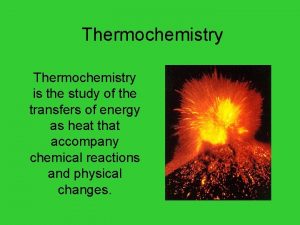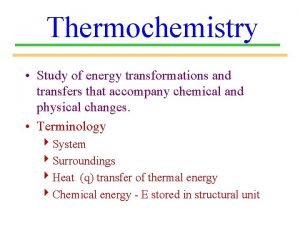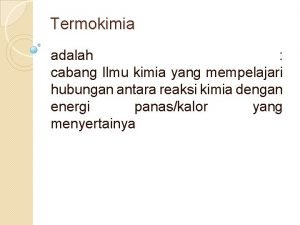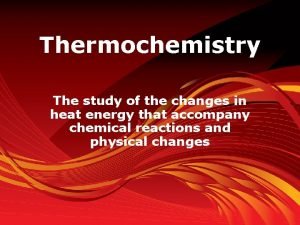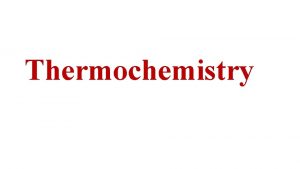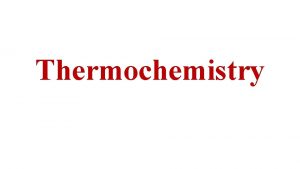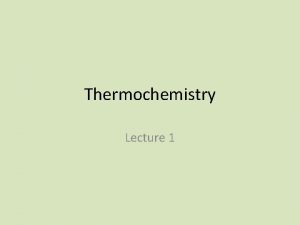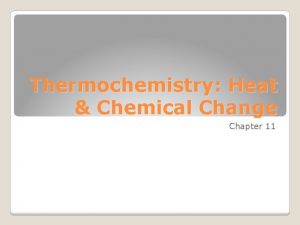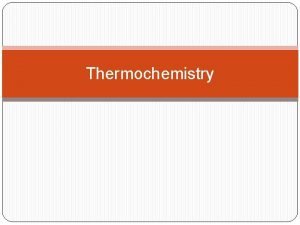Thermochemistry The study of heat changes that occur











- Slides: 11

Thermochemistry: The study of heat changes that occur during chemical reactions and physical changes of state

Energy • Heat (q) = – Form of energy – always flows from a warmer object to a cooler object • Law of Conservation of Energy – Energy is neither created nor destroyed

Heat (q) • The SI unit is the joule • 1 calorie = 4. 184 J • 1 Calorie (food) = 1000 cal (science) = 1 kcal

Specific Heat (C) • Specific Heat (C) – the amount of heat required to raise 1 gram of a substance by 1 C – Specific heat is an intensive property, – Every substance has its own specific heat • Ex. Water = 4. 184 J/(g ∙ ºC) Glass = 0. 50 J/(g ∙ ºC)

Specific Heat • Units for C = J / g ● ºC (joules per gram degree Celsius) • Equation for Specific Heat: C = q / (m Δ T) • This equation can be rearranged to solve for heat (q) q= CmΔT • C = specific heat; • q = heat; • m = mass and • ΔT = change in temperature (Tf – Ti)

Specific Heat • A 10. 0 g sample of iron changes temperature from 25. 0 C to 50. 4 C while releasing 114 joules of heat. Calculate the specific heat of iron.

Example • C= q/ (m∆T) • C=114 J/ (10. 0 g x 25. 4°C) • c = 0. 449 J/g C

Another example • If the temperature of 34. 4 g of ethanol increases from 25. 0 C to 78. 8 C how much heat will be absorbed if the specific heat of the ethanol is 2. 44 J/g C

Another example • First, rearrange the specific heat formula to solve for heat • q = Cm T • q = (2. 44 J/g°C)(34. 4 g)(78. 8°C – 25. 0°C) • q = 4520 J

Yet another example • 4. 50 g of a gold nugget absorbs 276 J of heat. What is the final temperature of the gold if the initial temperature was 25. 0 C & the specific heat of the gold is 0. 129 J/g C

Yet another example • • C= q/ (m∆T); rearrange to find ∆T = q / (C x m) ∆T = 276 J / (. 129 J/g°C x 4. 50 g) T = 475 C • T = Tf-Ti • 475 = Tf - 25 • Tf = 500 C
 Thermochemistry is the study of
Thermochemistry is the study of Thermochemistry is the study of
Thermochemistry is the study of Thermochemistry is concerned with the study of
Thermochemistry is concerned with the study of Thermochemistry is study of
Thermochemistry is study of Thermochemistry is the study of
Thermochemistry is the study of Ilmu kimia yang mempelajari tentang perubahan kalor disebut
Ilmu kimia yang mempelajari tentang perubahan kalor disebut Thermochemistry is study of
Thermochemistry is study of Q = m x cp x delta t
Q = m x cp x delta t Ngoại tâm thu thất chùm đôi
Ngoại tâm thu thất chùm đôi Block nhĩ thất độ 3
Block nhĩ thất độ 3 Thể thơ truyền thống
Thể thơ truyền thống Thơ thất ngôn tứ tuyệt đường luật
Thơ thất ngôn tứ tuyệt đường luật

